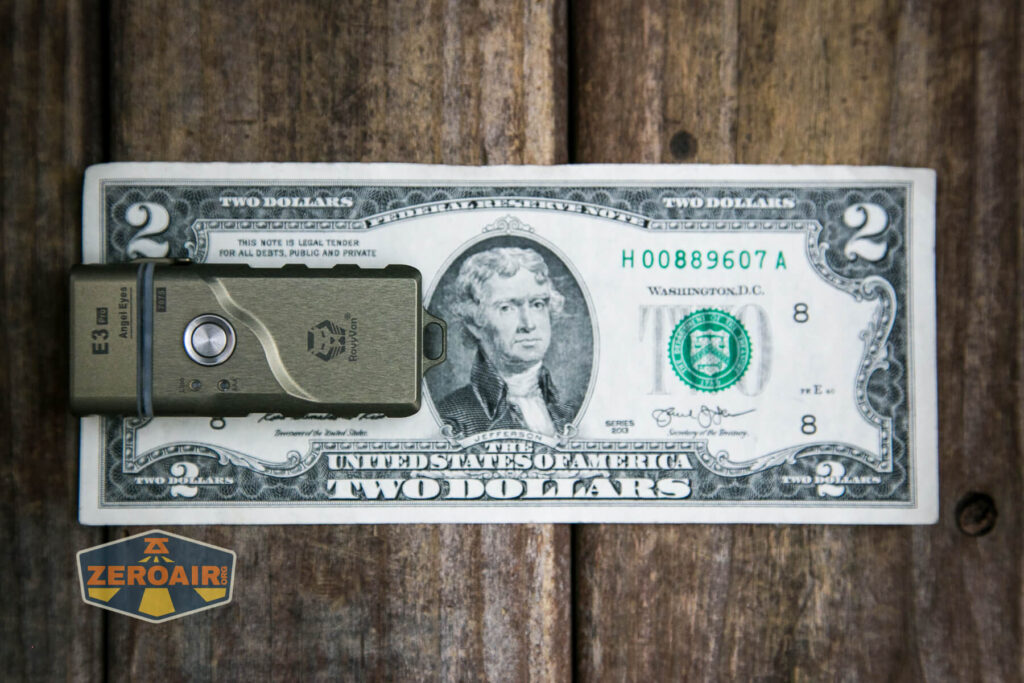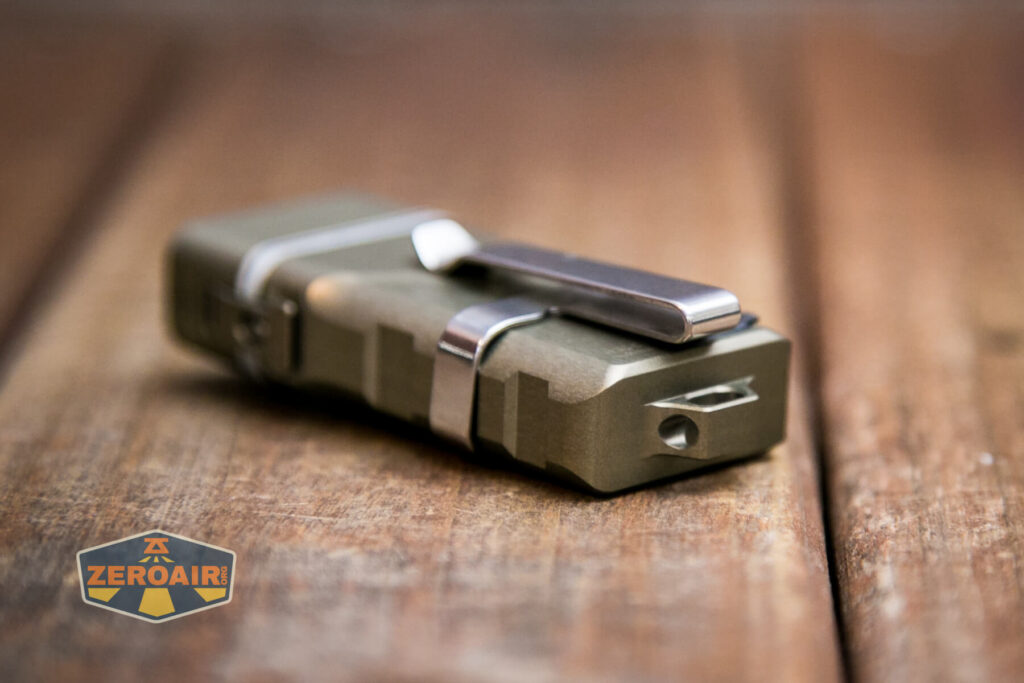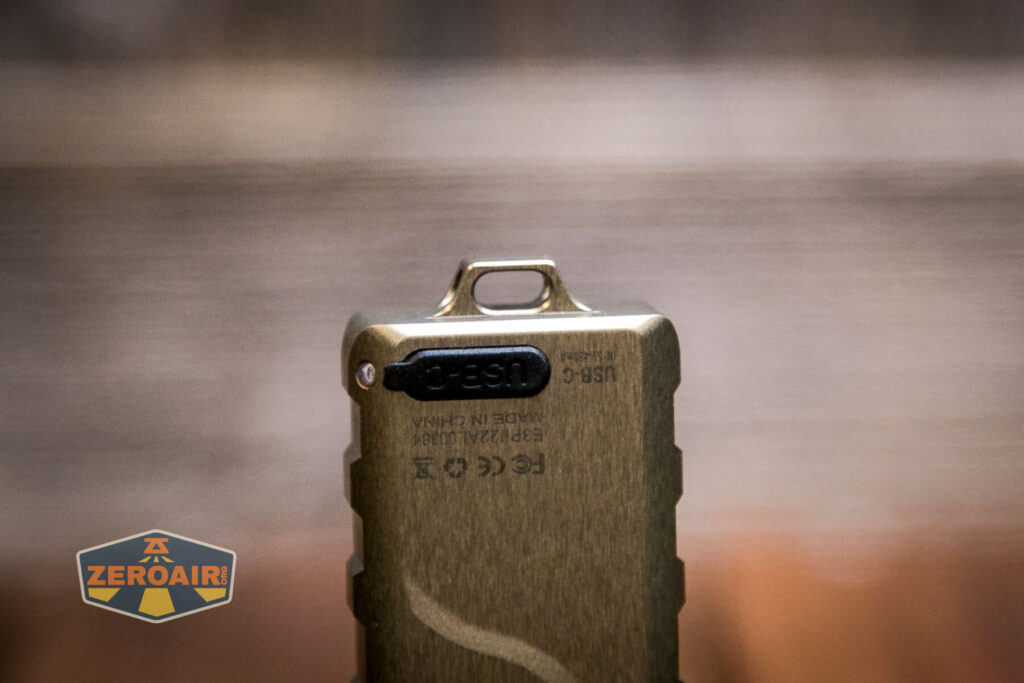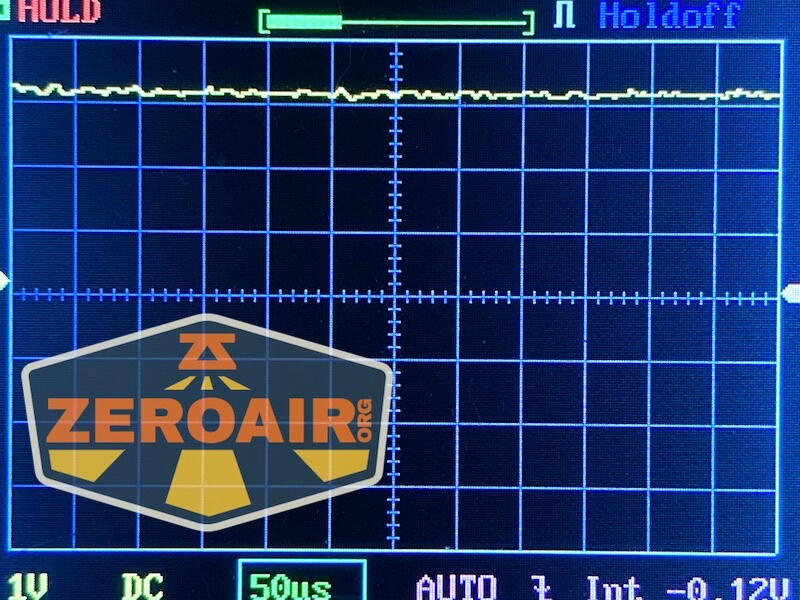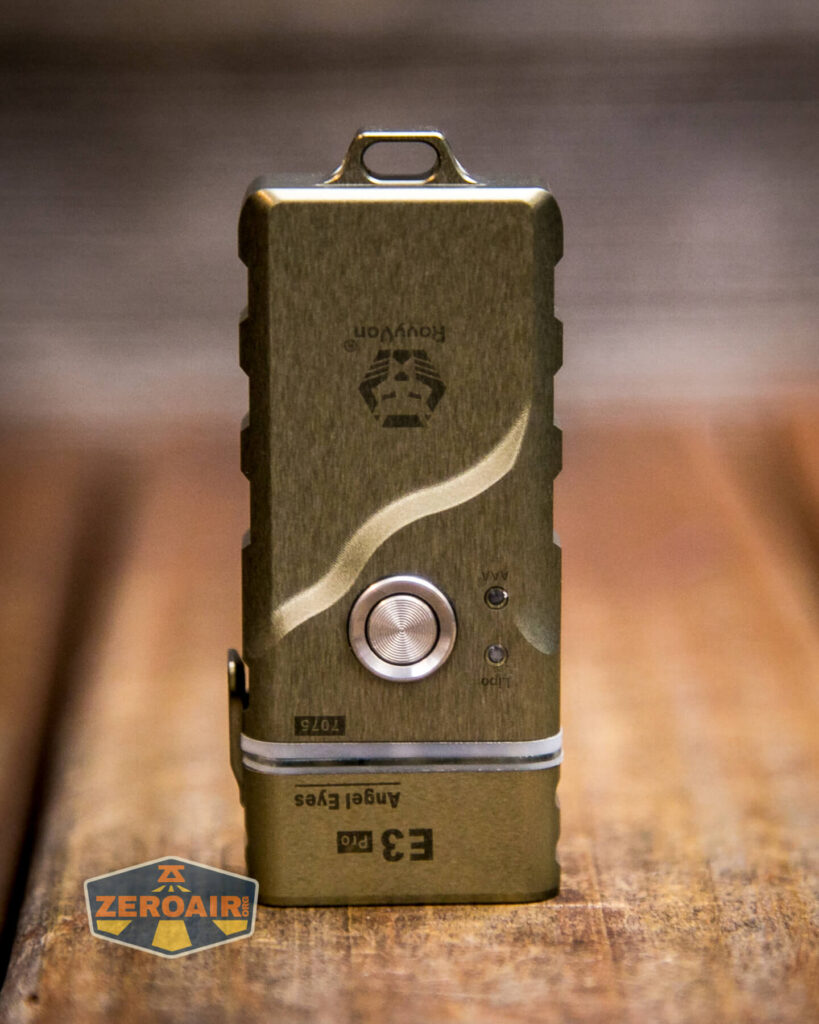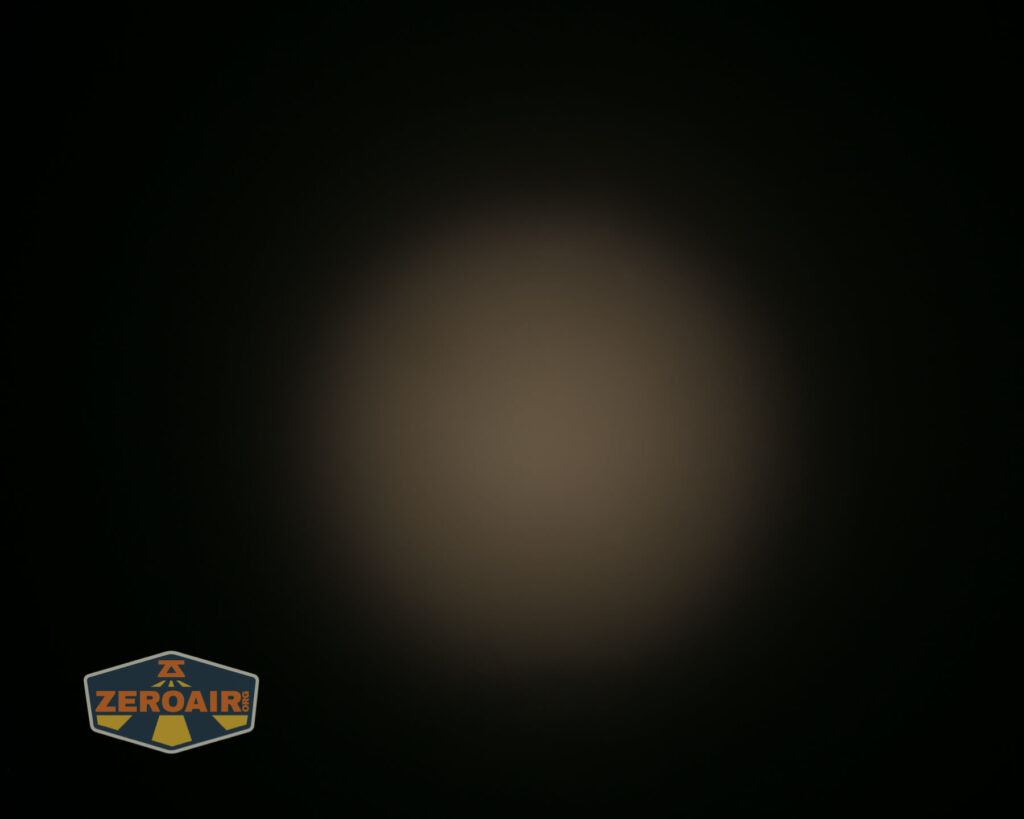RovyVon E3 Pro Keychain Flashlight Review
Another RovyVon Angel Eyes E3 flashlight, this time the Pro version! This little light with a built-in LiPO will run a single AAA cell!
Official Specs and Features
Here’s a link to the RovyVon Angel Eyes E3 product page.
Versions
There are a bunch of versions and a bunch of bodies! There’s blue (seen here), orange, green, black, gunmetal, and Desert Tan (only E3 Pro model, though).
There are also emitter options. Since there are two emitters, there’s the possibility of mixed options.
Cool white x2
Warm white High CRI x2
Cool white + warm white mix
Cool white + Red
Price
The RovyVon Angel Eyes E3 Pro flashlight sells for $49.95. The E3 is a bit less at $39.95.
Short Review
I thought this light would be “sort of neat” (and it is) but I actually really love it. It has all the characteristic RovyVon-ness that you’d want, but also is available in multiple emitter options including Warm white High CRI x2 (seen here.) The ability to run a single AAA cell is great, as well as running from the internal LiPO too. It’s just a very neat light! I will say that I’m not sure the Pro version adds just a whole lot to the mix. If you really need the extra durability that this higher-grade aluminum offers, then sure… But otherwise, and internally, it’s the same as the non-Pro. I do think buying the Pro is the only way to get this green color, though.
Long Review
The Big Table
| RovyVon Angel Eyes E3 Pro flashlight | |
|---|---|
| Emitter: | Luminus SST-20 (4000K, 95CRI) |
| Price in USD at publication time: | $49.95 |
| Cell: | Internal |
| High Runtime Graph | Medium Runtime Graph |
| LVP? | Warning |
| Switch Type: | E-Switch |
| Quiescent Current (mA): | ? |
| On-Board Charging? | Yes |
| Charge Port Type: | USB-C |
| Charge Graph | |
| Power off Charge Port | Lowest two modes only |
| Claimed Lumens (lm) | 400 |
| Measured Lumens (at 30s) | 289 (72.3% of claim)^ |
| Candela per Lumen | 6.2 |
| Claimed Throw (m) | 25 |
| Candela (Calculated) in cd (at 30s) | 162lux @ 3.041m = 1498cd |
| Throw (Calculated) (m) | 77.4 (309.6% of claim)^ |
| Claimed CCT | 4000 |
| Measured CCT Range (K) | 3800 Kelvin |
| Item provided for review by: | RovyVon |
| All my RovyVon reviews! | |
| RovyVon Angel Eyes E3 Pro flashlight | |
|---|---|
| Emitter: | Luminus SST-20 (4000K, 95CRI) |
| Price in USD at publication time: | $49.95 |
| Cell: | 1xAAA |
| High Runtime Graph | |
| LVP? | Warning |
| Switch Type: | E-Switch |
| Quiescent Current (mA): | ? |
| On-Board Charging? | Yes |
| Charge Port Type: | – |
| Power off Charge Port | Lowest two modes only |
| Claimed Lumens (lm) | 70 |
| Measured Lumens (at 30s) | 45 (64.3% of claim)^ |
| Candela per Lumen | 6.2 |
| Claimed Throw (m) | 25 |
| Candela (Calculated) in cd (at 30s) | 63lux @ 2.223m = 311cd |
| Throw (Calculated) (m) | 35.3 (141.2% of claim)^ |
| Claimed CCT | 4000 |
| Measured CCT Range (K) | 3800 Kelvin |
| Item provided for review by: | RovyVon |
| All my RovyVon reviews! | |
^ Measurement disclaimer: Testing flashlights is my hobby. I use hobbyist-level equipment for testing, including some I made myself. Try not to get buried in the details of manufacturer specifications versus measurements recorded here; A certain amount of difference (say, 10 or 15%) is perfectly reasonable.
What’s Included
- RovyVon Angel Eyes E3 Pro flashlight
- Pocket clip
- Split rings (2)
- Manual etc
Package and Manual
RovyVon upped their package game, I think.
Build Quality and Disassembly
Here’s the second installment of the RovyVon “Hybrid” series of flashlights. This little light features an internal lipo battery along with support for a single AAA cell. Interestingly they can sort of operate independently, but more on that later.
The build quality is great. This is very much like many of the RovyVon keychain lights (like the Aurora series) but I’d say it’s better build quality – it just feels sturdier in hand.
You can clearly see one big difference in this light and the other RovyVon lights. This one has a hinged front!
What’s more than just that little hinge piece is that the translucent seal you see there is actually a glow-in-the-dark seal!
Part of what makes this light so impressive is that the LiPO cell will keep the light working while still allowing you to swap the AAA cell! I’ll cover some details about this below in the user interface section.
Size and Comps
Size: 66.1mm (L) x 27.5mm (W) x 13.5mm (H)
Weight: 32g
If the flashlight will headstand, I’ll show it here (usually the third photo). If the flashlight will tailstand, I’ll show that here, too (usually the fourth photo).
Here’s the test light with the venerable Convoy S2+. Mine’s a custom “baked” edition Nichia 219b triple. A very nice 18650 light.
And here’s the light beside my custom engraved TorchLAB BOSS 35, an 18350 light. I reviewed the aluminum version of that light in both 35 and 70 formats.
Retention and Carry
The RovyVon Angel Eyes E3 Pro flashlight uses a typical RovyVon-style pocket clip. The clip hugs the body in a very tight manner. There are three grooves along the edge to allow different clip placements, but holding the light in hand, this (below) really seems like the only one that doesn’t block something else. Lower than this blocks the charge port. Higher than this blocks the head twist. On the other side blocks the switch.
Of course, you might want the pocket clip to block the switch as a form of accidental activation prevention, but the clip doesn’t come on and off easily enough to allow access when you want it.
There are also a couple of split rings included. You could probably use either of those, and they’ll attach easily on this tailcap bumpout.
I don’t love the tailcap area’s lanyard or split ring holder, but technically the light can tailstand on it. I would probably rather just skip the little loop and have a squared end.
Power and Runtime
There are two power sources for the RovyVon Angel Eyes E3 flashlight. First is an internal LiPo battery. As with many RovyVon flashlights, this battery is not user-serviceable.
The other power source is a 1.5V AAA cell. I’ve used this Amazon Basics NiMH cell for testing, but other types should work fine too (ie, primary alkaline, etc). A 10440 cell is supported but doesn’t affect output as you’d think. Output when using a 10440 is the same as output when using an AAA cell – ie the advantage is runtime, not output.
One interesting thing about the E3 is that it can still operate when the head is open, like when you’re swapping the AAA cell. This brings up some interesting user scenarios, which I’ll cover below.
There are some interesting points to make about the power source. The different power sources have different output levels. If the E3 has only the LiPO, then the output for the highest 3 modes is higher. If there’s an AAA cell installed, you get the lower modes.
The body has two little indicating LEDs to show which power source is being used, too.
When installing the AAA cell, you’ll put it into the E3 with the positive end (button) upward. When swinging the head back onto the body, you’ll need to press the cell down against a spring. This is easy, but you’ll want to pay attention so you don’t wear the seals when bumping them against the AAA button.

Above are two LiPO tests. Below is a test with an AAA. I would guess (but don’t really know) that the switch from a “fading” output (sloped) to absolutely flat output is when the light stops using the AAA cell and switches to the internal LiPO.
Charging
USB-C charging is available on the RovyVon Angel Eyes E3 Pro flashlight. This charging port is on the bottom and back of the light. The cover presses in and says in place fairly well.
Beside the charging port is yet another LED to indicate the charging status while charging. When solid blue, charging is complete. If charging is ongoing, the blue indicator will “breathe” – not quite a blink, but a slow fade in and out. Also, this LED is tiny (like the ones on the front) and not overpowering in a dark room (like your bedroom or wherever you normally charge lights!). It’s a good indicator.
Not just all those good factors mentioned above, but this charging works with USB-C to USB-C, too! Here are a couple of charging graphs. Actual charging time is around 45 minutes. If you leave the light on charging, it’ll blip a bit of charge every little while. I am not sure if that’s responsive charging (responding to parasitic draining drawdown) or if it’s just time based and could potentially overcharge the cell. Either way I’d recommend pulling the light off charging after an hour or so.
Unfortunately, I think the onboard charging is only for the internal LiPO battery. You won’t be able to charge an AAA cell with USB-C charging.
Modes and Currents
LiPO:
| Mode | Mode Claimed Output (lm) | Claimed Runtime | Measured Lumens | Tailcap Amps |
|---|---|---|---|---|
| High | 400 | 3m+1h | 289 | – |
| Medium | 70 | 1.8h | 44 | – |
| Low | 10 | 12h | 4.4 | – |
| Moonlight | 0.5 | 54h | 0.02 | – |
| Mode | Mode Claimed Output (lm) | Claimed Runtime | Measured Lumens | Tailcap Amps |
|---|---|---|---|---|
| High | 70 | – | 44 | – |
| Medium | 15 | – | 8.9 | – |
| Low | 5 | – | 2.5 | – |
| Moonlight | 0.5 | – | 0.02 | – |
Pulse Width Modulation
None of the modes with either power source use PWM.
Here you can see a “baseline” – a chart with almost no light hitting the sensor.
Then there’s the Ultrafire WF-602C flashlight, which has some of the worst PWM I’ve seen. It’s so bad that I used a post about it to explain PWM! Here are multiple timescales (10ms, 5ms, 2ms, 1ms, 0.5ms, 0.2ms) to make comparing this “worst” PWM light to the test light easier. That post also explains why I didn’t test the WF-602C at the usual 50us scale.
User Interface and Operation
The switch on this RovyVon Angel Eyes E3 Pro flashlight is a metal cover e-switch. It’s very much in design like the Aurora A24Ti (for example, but there are others.) The regular E3 is another example, of course.
A bezel around the switch protects it reasonably well from accidental activation.
It’s a very quiet clicky button. Despite the similarity between other lights, the user interface has seen some changes. That’s understandable because this light has a different feature set! Note that the user interfaces for lights with mixed emitters is slightly different. On those lights, the emitters can be controlled independently. However, there are many user interface aspects that cover all the lights in this series, too.
Here’s a user interface table!
| State | Action | Result |
|---|---|---|
| Off | Click | Moonlight (and brief battery check display on LiPO/AAA LED) |
| Off | Double Click | Memorized mode (from Low, Medium, or High) (and brief battery check display on LiPO/AAA LED) |
| Off | Hold | Momentary High (and brief battery check display on LiPO/AAA LED) |
| Moonlight | Click | Off |
| Moonlight | Triple Click | Iterate battery selection (pick between AAA or LiPO option) (or three blinks from LiPO LED to indicate “switch failed” (maybe AAA is not installed or depleted) |
| Off | Click 4x | Lockout (LiPO LED blinks 3x rapidly to indicate lockout) |
| Lockout | Click | LiPO LED blinks 3x rapidly to indicate lockout |
| Lockout | Click 4x | Unlock (AAA LED blinks 2x rapidly to indicate unlock) |
| On (except Moonlight) | Click | Mode advance (L, M, H) |
| On (except Moonlight) | Hold 0.5s | Off |
| Off (or in L,M,H) | Click 3x | Strobe in “High” of the selected battery |
LED and Beam
This warm white version uses two Luminus SST-20 emitters in (4000K) High CRI (95). For the record, the cool white is also a Luminus SST-20, but in 6500K CCT. I have petitioned RovyVon to make an orange body version (which they already do make) with warm white emitter and an amber secondary. Let’s hope!!
LED Color Report (CRI and CCT)
The claim made about these Luminus SST-20 emitters is that they’re 4000K and 95 CRI. What we actually get is something a bit warmer, in the 3800-3900K range. This pleases me greatly! But it might not please you, so be aware. Also, the claim is 95 CRI and across the board, the CRI is higher, at 97-98. All very good things! In almost all tests, the dUV is very slightly below the BBL, too. It’s minimal, and you will probably not notice it, but you should be able to note that there’s no green at all. That alone is very good! One more point is that both CRI and CCT hold up no matter which battery you’re using. And they’re both consistent across all the modes – so this is one very consistent output light!!
Beamshots
These beamshots always have the following settings: f8, ISO100, 0.3s shutter, and manual 5000K exposure. These photos are taken at floor level, and the beam hits the ceiling around 9 feet away.
Tint vs BLF-348 (KillzoneFlashlights.com 219b version) (affiliate link)
I keep the test flashlight on the left and the BLF-348 reference flashlight on the right.
I compare everything to the KillzoneFlashlights.com 219b BLF-348 because it’s inexpensive and has the best tint!
Conclusion
What I like
- Unique LiPO/AAA mix
- LiPO can still power the light when AAA is being swapped – continuous usage!
- Possible to select between battery options (even with AAA installed) (this allows access to the 400 lumens high even if AAA is installed)
- Warm white emitter options
- Great build quality
- USB-C charging
- Luminus SST-20 is a great emitter choice!
- Indicator LEDs are quite useful
- C to C charging works!
- Glow gasket between head and body
- There’s an orange body option!
- E3 Pro uses higher grade of aluminum (7075)
What I don’t like
- LiPO can’t be changed
- Might be good to be able to control the same-emitters (like cool/cool and warm/warm) independently just like with the mixed emitter options
- There’s no warm white and red option (warm white and amber would be the best option!)
- Latch can be a bit hard to lift (but at least it seems secure)
- If the latch gets damaged, then the seal between head and body will be questionable (at best)
- USB-C charging doesn’t charge the AAA cell
Notes
- This content originally appeared at zeroair.org. Please visit there for the best experience!
- For flashlight-related patches, stickers, and gear, head over to PhotonPhreaks.com!
- Please use my amazon.com referral link to help support zeroair.org!
- Please support me on Patreon! I deeply appreciate your support!















